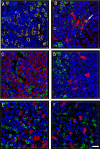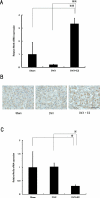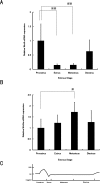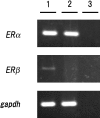The expression of Wnt4 is regulated by estrogen via an estrogen receptor alpha-dependent pathway in rat pituitary growth hormone-producing cells
- PMID: 20126574
- PMCID: PMC2808504
- DOI: 10.1267/ahc.09033
The expression of Wnt4 is regulated by estrogen via an estrogen receptor alpha-dependent pathway in rat pituitary growth hormone-producing cells
Abstract
Wnt signaling is important in many aspects of cell biology and development. In the mouse female reproductive tract, Wnt4, Wnt5a, and Wnt7a show differential expression during the estrus cycle, suggesting that they participate in female reproductive physiology. Although the pituitary is a major gland regulating reproduction, the molecular mechanism of Wnt signaling here is unclear. We elucidated the subcellular distribution of Wnt4 in the pituitary of estrogen-treated ovariectomized female rats. Expression of Wnt4 mRNA increased dramatically, particularly in proestrus compared with estrus and metestrus. Wnt4 protein was observed in the cytoplasm of almost all growth hormone (GH)-producing cells and in only a few thyroid-stimulating hormone beta (TSHbeta)-producing cells. In rat GH-producing pituitary tumor (MtT/S) cells, estrogen-induced expression of Wnt4 mRNA was completely inhibited by estrogen receptor antagonist ICI 182,780 in vitro. Thus, rat pituitary GH cells synthesize Wnt4 and this is induced by estrogen mediated via an estrogen receptor alpha-dependent pathway.
Keywords: Wnt signaling; estrogen; estrus cycle; growth hormone; pituitary gland.
Figures








Similar articles
-
Expression of Wnt4 in human pituitary adenomas regulates activation of the beta-catenin-independent pathway.Endocr Pathol. 2008 Winter;19(4):261-73. doi: 10.1007/s12022-008-9048-9. Endocr Pathol. 2008. PMID: 19034702
-
Specific binding of LH-RH to the anterior pituitary gland during the oestrous cycle in the rat.Acta Endocrinol (Copenh). 1976 May;82(1):62-70. doi: 10.1530/acta.0.0820062. Acta Endocrinol (Copenh). 1976. PMID: 178137
-
Estrogen receptors are involved in xenoestrogen induction of growth hormone in the rat pituitary gland.J Reprod Dev. 2009 Apr;55(2):206-13. doi: 10.1262/jrd.20147. Epub 2009 Jan 15. J Reprod Dev. 2009. PMID: 19145065
-
A calcium binding protein, calbindin-D9k, is mainly regulated by estrogen in the pituitary gland of rats during estrous cycle.Brain Res Mol Brain Res. 2005 Nov 30;141(2):166-73. doi: 10.1016/j.molbrainres.2005.09.008. Epub 2005 Oct 21. Brain Res Mol Brain Res. 2005. PMID: 16246455
-
WNT4 mediates estrogen receptor signaling and endocrine resistance in invasive lobular carcinoma cell lines.Breast Cancer Res. 2016 Sep 20;18(1):92. doi: 10.1186/s13058-016-0748-7. Breast Cancer Res. 2016. PMID: 27650553 Free PMC article.
Cited by
-
Oestrogen-induced epithelial-mesenchymal transition (EMT) in endometriosis: Aetiology of vaginal agenesis in Mayer-Rokitansky-Küster-Hauser (MRKH) syndrome.Front Physiol. 2022 Dec 13;13:937988. doi: 10.3389/fphys.2022.937988. eCollection 2022. Front Physiol. 2022. PMID: 36582359 Free PMC article. Review.
-
WNT signaling suppression in the senescent human thymus.J Gerontol A Biol Sci Med Sci. 2015 Mar;70(3):273-81. doi: 10.1093/gerona/glu030. Epub 2014 Mar 22. J Gerontol A Biol Sci Med Sci. 2015. PMID: 24657825 Free PMC article.
-
Inside the Endometrial Cell Signaling Subway: Mind the Gap(s).Int J Mol Sci. 2018 Aug 21;19(9):2477. doi: 10.3390/ijms19092477. Int J Mol Sci. 2018. PMID: 30134622 Free PMC article. Review.
-
Transcriptomic Analysis of Pubertal and Adult Virgin Mouse Mammary Epithelial and Stromal Cell Populations.J Mammary Gland Biol Neoplasia. 2024 Jun 25;29(1):13. doi: 10.1007/s10911-024-09565-1. J Mammary Gland Biol Neoplasia. 2024. PMID: 38916673 Free PMC article.
-
Experimental gastritis leads to anxiety- and depression-like behaviors in female but not male rats.Behav Brain Funct. 2013 Dec 17;9:46. doi: 10.1186/1744-9081-9-46. Behav Brain Funct. 2013. PMID: 24345032 Free PMC article.
References
-
- Cadigan K. M., Nusse R. Wnt signaling: A common theme in animal development. Genes Dev. 1997;11:3286–3305. - PubMed
-
- Camper S. A., Saunders T. L., Katz R. W., Reeves R. H. The pit-1 transcription factor gene is a candidate for the murine snell dwarf mutation. Genomics. 1990;8:586–590. - PubMed
-
- Cowley S. M., Hoare S., Mosselman S., Parker M. G. Estrogen receptors alpha and beta form heterodimers on DNA. J. Biol. Chem. 1997;272:19858–19862. - PubMed
LinkOut - more resources
Full Text Sources
Other Literature Sources
Molecular Biology Databases
Research Materials

